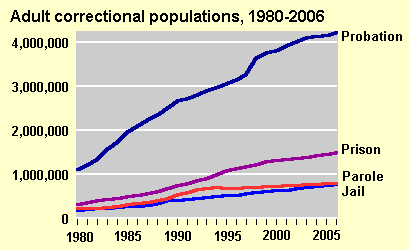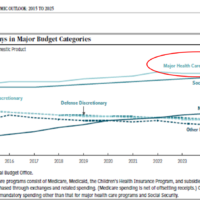A recent report from the Pew Foundation indicated that 1 out of 100 adults in the US get free government health care with no premiums, deductibles or co-payments. The reason this report didn’t get more media attention was because the 1% of Americans getting free government health care are behind bars – as in prison or jail.
The Pew report indicates that for the first time, more than 1 in 100 adults in America are in prison or jail. That’s over 2.3 million in state or federal prisons or local jails, and the numbers and percentages have been growing. (See the Department of Justice chart below)
This data is an interesting launching point into other aspects of our current health care system’s problems:
First, health care costs for people behind bars represent about 10% of the costs of incarceration. (In 2004 this was about $3.7 billion.) And as the Pew report notes, “Under the 1976 U.S. Supreme Court ruling Estelle v. Gamble, states are compelled to provide a constitutionally adequate level of medical care, or care that generally meets a “community standard.” (I assume that Federal prisons are required to meet a similar standard.)
This was the basis for Harris Wofford’s 1991 successful campaign message, (in a special election for the US Senate), that Americans in jail have a guaranteed right to health care, but nobody else does. He was quoted in the New York Times in 1994 as saying about health insurance: “The wealthy have it. The poor have it. If you go to jail, you have it. Only the middle class doesn’t have it, and I don’t think that makes much sense.” (It will be interesting to see how the health care issues of costs and access play out in this year’s elections.)
Second, upon leaving prison (or jail) these individuals are not automatically enrolled in any type of health insurance. Given that they are likely making a difficult transition back into unincarcerated society, health insurance paperwork is probably not their highest priority. A study done by the American Public Health Association of parolees in Los Angles County described these challenges:
Many of the parolees’ illnesses go undiagnosed and untreated by prison physicians. To exacerbate the problem, California’s prison-based health care system does not prepare parolees to use public and private health clinics in the counties where they will reside. There is no coordination between counties and prisons in planning for the continued care of inmates after they are released.
Most parolees do not have medical insurance or stable sources of medical services. Eligible parolees may sign up for various programs but few do, often because they are unable to complete required application forms, do not possess appropriate personal identification documents, and/or have no permanent address. If parolees do succeed in applying for public health insurance programs, they often experience long delays while their enrollments are finalized.
Third, these individuals have more health care needs than average. As the APHA report found, parolees in LA County had:
- 4 times higher rate of active tuberculosis
- 9-10 times higher rate of hepatitis C
- 5 times higher rate of AIDS
- 1.5 -5 times higher rate of mental illness
Fourth, about 25% of children get health insurance through Medicaid or the State Children’s Health Insurance Program (~34 million), about another 24 million adults have insurance through Medicaid, about 3 million Americans get health care from the Veterans Affairs (VA) health system, and over 8 million have health insurance benefits through the Federal Employees Health Benefits Program.
Together this all paints a picture where multiple government health systems lack coordination. One of the most likely pairs for coordination would be the government run Department of Defense and Veterans Administration health programs, but they have had significant coordination problems that they continue to work on today. Conversely, one of the best examples of coordination may be in the private sector, where people can transition from one private insurer to another if they maintain insurance coverage. However, this ability is not an innate result of the market, but was a provision in the Health Insurance Portability and Accountability Act (HIPAA) of 1996, and illustrates the managed-market reality of the US health care system.
Some would argue that this all just means we should have a single-payer health care system. However, while that may look good in theory, the challenges of getting from our current system to a single payer program are beyond huge. And even if that is our ultimate goal, getting better coordination between programs would make lots of sense – as would making it easier (or routine) for people being released from behind bars to get health insurance. After all, we do this for people leaving their jobs by enabling them to continue their employee coverage (this was in the 1986 COBRA law), and then transition to another private insurance plan under HIPAA. So we should be able to do something similar for people being released from jail, shouldn’t we?
What do you think?


